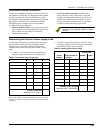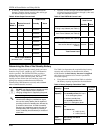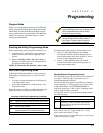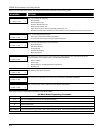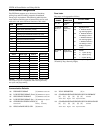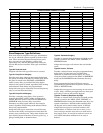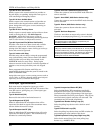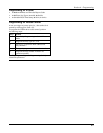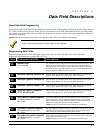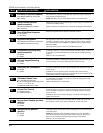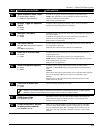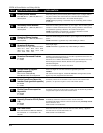
Section 4 – Programming
4-5
Communication Defaults for Zones
ZONE # 1st 2nd ZONE # 1st 2nd ZONE # 1st 2nd ZONE # 1st 2nd
1 01 00 21 06 00 41 11 00 61 01 00
2 02 00 22 07 00 42 12 00 62 02 00
3 03 00 23 08 00 43 13 00 63 02 00
4 04 00 24 09 00 44 14 00 64 04
5 05 00 25 10 00 45 15 00 70 00 00
6 06 00 26 11 00 46 01 00 88 00 00
7 07 00 27 12 00 47 02 00 89 00 00
8 08 00 28 13 00 48 03 00 90 00 00
9 09 00 29 14 00 49 04 00 91 00 00
10 10 00 30 15 00 50 05 00 92 (DURESS) 11 00
11 11 00 31 01 00 51 06 00 95 00 00
12 12 00 32 02 00 52 07 00 96 00 00
13 13 00 33 03 00 53 08 00 97 06 00
14 14 00 34 04 00 54 09 00 99 06 00
15 15 00 35 05 00 55 10 00 ALARM RST. 00 00
16 01 00 36 16 00 56 11 00 TROUBLE 00 00
17 02 00 37 17 00 57 12 00 TRBLE. RST 00 00
18 03 00 38 18 00 58 13 00 BYPASS 00 00
19 04 00 39 19 00 59 14 00 BYP. RST. 00 00
20 05 00 40 10 00 60 15 00
Zone Response Type Definitions
Each zone must be assigned a zone type, which defines
the way in which the system responds to faults in that
zone. There are three keypad-activated zones (panic
keys; see note) for each partition, a polling loop
supervision zone, and four RF supervisory zones, two
for each RF receiver installed. Zone types are defined
below.
Type 00: Zone Not Used
Program with this zone type if the zone is not used.
Type 01: Entry/Exit #1 Burglary
Provides entry delay whenever the zone is faulted and
the system is armed in the AWAY or STAY mode. When
the panel is armed in the INSTANT or MAXIMUM
mode, no entry delay is provided. Exit delay begins
whenever the control is armed, regardless of the arming
mode selected. These delays are programmable.
Assign this zone type to zones that are used for primary
entry to and exit from the facility.
Type 02: Entry/Exit #2 Burglary
Provides a secondary entry delay, if the system is
armed in the AWAY or STAY modes and the zone is
faulted. When the panel is armed in the INSTANT or
MAXIMUM mode, no entry delay is provided.
Secondary exit delay begins whenever the control is
armed, regardless of the arming mode selected. These
delays are programmable.
Assign this zone type to zones that are used for entry
and exit of the facility and require more time than the
primary entry and exit point. Delay times for this zone
type must be greater than those for zone type 01 (e.g., a
garage, loading dock, or basement door).
Type 03: Perimeter Burglary
Provides an instant alarm if the zone is faulted and the
system is armed in the AWAY, STAY, INSTANT, or
MAXIMUM mode.
Assign this zone type to all exterior door and window
zones.
Type 04: Interior, Follower
Provides a delayed alarm (using the programmed entry
delay time) if an entry/exit zone is faulted first.
Otherwise it produces an instant alarm. It is active
when the system is armed in the AWAY or MAXIMUM
mode, but the MAXIMUM mode eliminates the entry
delay.
Zones programmed for Interior Follower zone are
automatically bypassed when the panel is armed in the
STAY or INSTANT mode.
Assign this zone type to a zone covering an area such as
a foyer, lobby, or hallway through which one must pass
upon entry or exit (to and from the keypad).
Type 05: Trouble by Day/Alarm by Night
Provides an instant alarm if the zone is faulted and the
system is armed in the AWAY, STAY, INSTANT, or
MAXIMUM mode. During the disarmed state (day), the
system annunciates a latched trouble sounding from
the keypad (and a central station report, if desired).
Assign this zone type to a zone that contains a foil-
protected door or window (such as in a store), or to a
zone covering a sensitive area such as a stock room or
drug supply room. It can also be used on a zone in an
area where immediate notification of an entry is
desired.



